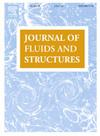Shifting aeroacoustic source mechanisms of a transversely oscillating cylinder in lock-in region at various Mach numbers
IF 3.5
2区 工程技术
Q1 ENGINEERING, MECHANICAL
引用次数: 0
Abstract
Direct numerical simulation of the aerodynamic noise generated by a flow past a transversely oscillating cylinder is conducted to investigate the effect of Mach number on the aeroacoustic characteristics. The results indicate that the coupling between the oscillating motion and vortex shedding in the lock-in region leads to a distribution of the surface pressure pulsation time derivative with four distinct peaks. The intensity of the radiated noise from the oscillating cylinder in the lock-in region is reduced compared to the stationary case. Although the oscillating frequency associated with this noise reduction is insensitive to Mach number, the reduction effect weakens at high Mach numbers. Furthermore, as the Mach number increases, the sound directivity at the lock-in boundary transitions from a figure-eight configuration to a butterfly-like configuration, featuring distinct lobes both upstream and downstream. To illustrate the changes in noise, the key finding is the modified scaling law governing noise intensity in relation to Mach number for the oscillating cylinder: it shifts from to , characteristic of quadrupole sources. This alteration is further analyzed by applying the Ffowcs Williams-Hawkings equation to separate the contributions of different noise sources, and utilizing spectral proper orthogonal decomposition to extract the dominant coherent structures responsible for the oscillating cylinder at the lock-in boundary at high Mach numbers.
不同马赫数下锁闭区横向振荡圆柱体移动气动声源机理
为了研究马赫数对横摆圆柱气流噪声的影响,对横摆圆柱气流噪声进行了直接数值模拟。结果表明:锁相区振荡运动与旋涡脱落的耦合作用导致表面压力脉动时间导数呈四个明显的峰值分布;与静止情况相比,锁相区振荡圆柱体的辐射噪声强度减小。虽然与此降噪相关的振荡频率对马赫数不敏感,但在高马赫数时降噪效果减弱。此外,随着马赫数的增加,锁定边界处的声指向性从8字形结构转变为蝴蝶状结构,上游和下游都有明显的叶状结构。为了说明噪声的变化,关键的发现是控制噪声强度与振荡圆柱体马赫数相关的修正比例定律:它从M2.5转移到M3.5,这是四极源的特征。利用Ffowcs williams - hawkins方程分离不同噪声源的贡献,并利用频谱固有正交分解提取高马赫数下锁相边界处导致圆柱振荡的主导相干结构,进一步分析了这种变化。
本文章由计算机程序翻译,如有差异,请以英文原文为准。
求助全文
约1分钟内获得全文
求助全文
来源期刊

Journal of Fluids and Structures
工程技术-工程:机械
CiteScore
6.90
自引率
8.30%
发文量
173
审稿时长
65 days
期刊介绍:
The Journal of Fluids and Structures serves as a focal point and a forum for the exchange of ideas, for the many kinds of specialists and practitioners concerned with fluid–structure interactions and the dynamics of systems related thereto, in any field. One of its aims is to foster the cross–fertilization of ideas, methods and techniques in the various disciplines involved.
The journal publishes papers that present original and significant contributions on all aspects of the mechanical interactions between fluids and solids, regardless of scale.
 求助内容:
求助内容: 应助结果提醒方式:
应助结果提醒方式:


